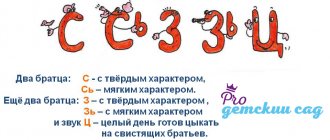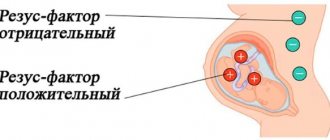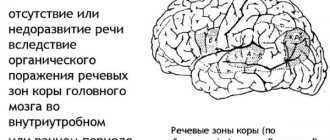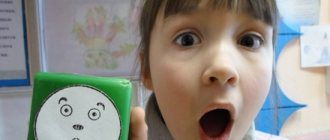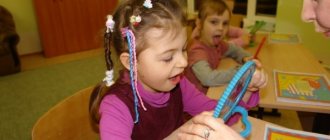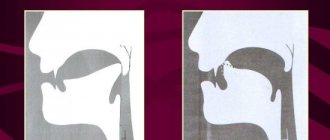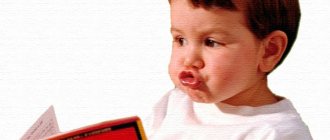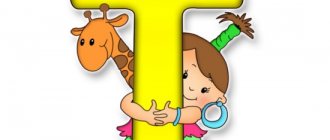Features of articulation
The problem of incorrect sound pronunciation (if the child does not have other speech problems, for example, dysarthria) of sonorant sounds is the difficulty in their articulation. This is especially true for R, so speech therapists advise parents not to panic if their child does not “growl” at three years old. The articulatory apparatus must be prepared, which happens by the age of 4-5, so be sure to do articulatory gymnastics with your child.
When pronouncing P, the organs of the articulatory apparatus occupy the following position:
- the mouth is open, the lips are in the position of the vowel sound following P;
- the tongue should be wide, located behind the upper teeth and touching the alveoli, the lateral edges should be raised; it is shaped like a small ladle;
- the soft palate is raised;
- vocal cords vibrate.
In addition to the correct position of the organs of the articulatory apparatus, a strong air stream is needed, because when exhaling it is directed to the tip of the tongue, resulting in its vibration and a “rumbling” sound.
The tip of the tongue should vibrate, not the small tongue or its side. You can check the direction of the air stream using a strip of paper: if pronounced correctly, it will sway.
Breathing exercises
The sound R is quite difficult for children to pronounce, so correctly performed speech breathing will significantly speed up and facilitate the main work of producing and automating the sound. It is with breathing exercises that every speech therapy session should begin. The following exercises are great for this purpose.
"Playing football". Two cubes are placed on the table - these are gates. Use a small cotton ball as a ball. The child’s task is to stretch out his lips with a tube and, with a long exhalation, blow on the ball, driving it into the goal.
"Magic Bubbles" In front of the child is a glass of water and a cocktail straw. For added interest, you can add any food coloring to the water. The baby blows into the straw, creating a storm of bubbles in the glass.
"Snowflake on the nose." A small cotton ball on the tip of the child’s nose acts as a snowflake. The task is to blow off the cotton wool with a stream of air with your mouth slightly open and the tip of the tongue attached to the upper lip.
Types of violations
Violation of the pronunciation of the sounds R and R` is called rhotacism and pararotacism.
There are several options:
- Absence of sound in speech - the child does not use another sound instead (for example, “cow” instead of “cow”).
- Velar - occurs when the back of the back of the tongue rises too much and comes into contact with the soft palate. As a result, a gap is formed and when air passes through it, the walls of the sky create additional noise, which distorts the pronunciation of sound. This disorder is called burr.
- Uvular - only the small tongue vibrates. This type of rotacism is called throat rhotacism.
- Side – the side edge vibrates. When pronounced, the sounds R and L` are combined.
- Bilibial - this type of disorder is rare. The child creates a vibration with his lips and produces a sound similar to “prrr”.
- Labiodental - the sound is produced between the upper lip and lower teeth, and vice versa.
- Single-beat or proto sound - the tip of the tongue makes only one blow on the alveoli, and long vibrations are not obtained. The pronounced sound has a D sound; the child cannot pronounce the long, rolling R.
- Buccal - the air stream passes through the cheek and lateral edges of the tongue, which causes vibration of the cheeks.
- Interdental - the tongue is located between the teeth.
- Laryngeal - the sound P occurs as a result of strong tension of the vocal cords.
Pararotacism is the replacement of one sound with another. The sound R is often replaced with its soft version, or replaced with L, which is simpler in articulation.
This sound is also replaced by the following sounds:
- B - “pavahod” instead of “parachod”;
- D – “duca” instead of “hand”;
- G – “pagavoz” instead of “paravoz”;
- Y – “yiba” instead of “fish”.
Rhotacism may be a reflection of simple dyslalia, when the pronunciation of one sound is impaired. Or is it a variant of complex dyslalia, when the sound pronunciation of several groups of sounds is impaired. Rotacism and pararotacism may indicate more complex speech disorders - dysarthria, alalia, rhinolalia.
Reasons for violations
Why does a child have a problem with the pronunciation of R? There are several reasons, and to eliminate some of them you need the help of several specialists, not just a speech therapist:
- Anatomical features. These include a shortened hyoid frenulum, cleft lip, palate, and malocclusion.
- The air stream is not strong enough.
- Incorrect position of the organs of articulation - there are no anatomical disorders, but, for example, the tongue is in the wrong position because the child did not remember the correct articulation.
- Incorrect speech environment - often parents worry that if they burr, then their children will pronounce R incorrectly. This is not a genetic predisposition, but an incorrect speech environment. The child hears the incorrect pronunciation and tries to copy it. This is why rotacism arises.
- The child does not distinguish sounds by ear - this is a violation of the phonetic processes.
In addition, if there is a complex speech disorder - alalia, then incorrect sound pronunciation may be a consequence of insufficient activity of the speech areas of the brain. It is important to determine the exact cause of rhotacism and pararotacism in order to draw up a plan for corrective work.
Reasons for incorrect pronunciation
A child may not be able to pronounce vibrant for various reasons. Let's list them:
- Anomalies of the frenulum - it may be shortened and incorrectly positioned. In some children, the hyoid ligament can be stretched with exercises. But sometimes the bridle has to be cut;
- Features of the structure of the tongue - its narrowing or enlargement (macroglossia);
- Anatomy of the jaws - a narrow upper jaw, an incorrect bite can also interfere with the pronunciation of the vibrant;
- Anomalies of the palate - with a cleft or gothic palate, vibrants are difficult to achieve;
- Incorrect location or absence of teeth in the upper jaw;
- Hearing abnormalities - in this case, the baby may not perceive vibrant by ear, an even more difficult situation is physical hearing impairment;
- Hypotonia - weak muscles are characteristic of dysarthria;
- Imitation. It often happens that a child pronounces vibrant, but comes to a children's group, where the children “burr.” And he begins to repeat after them - the skill is lost.
Its correction also depends on the cause of the speech disorder. This requires consultation with a neurologist and speech therapist. The specialist will write out a program for stage-by-stage sound production. The earlier the correction is started, the easier it is to achieve good results.
Stage 1: preparation for correctional work
It consists of identifying the sound “p” and its substitute by ear and comparing their articulation. To develop the articulatory skills that are needed to make the sound “r”, the speech therapist prescribes special exercises for the little patient - for the lips, tongue and lower jaw.
At the stage of preparation for sound production, it is necessary to introduce the baby to the parts of his language. The easiest way to show them is on the palm of your hand: tip, back, edges, tummy. This will make it easier for your baby to do the exercises.
Stage 2: setting the sound “r”
There are several approaches: staging by imitation, from other sounds, mechanically and with the help of gymnastics. Next we will look at these staging methods in more detail.
Stage 3: vibrant automation
To do this, the child pronounces syllables and words, and then more complex tongue twisters, tongue twisters, rhymes and phrases - with different stress and vowel. This allows you to bring pronunciation to automaticity.
Stage 4: introducing vibrant into speech
The final sound “r” is formed in children within 25–40 days, sometimes it takes up to 60 days. Although there are often cases when the correction continues throughout the year. You need to work with a speech therapist at least twice a week, and continue the rest of the days at home on the recommendation of a specialist.
Speech therapy diagnostics
To determine whether there is a violation of the sonorous group, you need to select speech material. But the examination begins with checking the articulatory apparatus. The specialist pays attention to their anatomical structure. Then evaluates the work using exercises (for example, raising and lowering the tongue).
The speech therapist checks speech breathing. To do this, he asks the child to play wind instruments (pipes); blow on a piece of cotton wool. Thus, the specialist watches how the child inhales and exhales and the force of exhalation.
The sound R must be present in forward and backward syllables, at the beginning, middle and end of the word. You also need to select syllables with a combination of consonants (for example, TRA, KRA and others). It happens that a child can pronounce R and R` paired with consonants - it is important to reflect such moments in speech therapy diagnostics.
You also need to check phonetic processes: the speech therapist calls the child isolated sounds and asks him to clap his hands or raise his hand to the desired sound. Then they also check P in syllables and words. The speech therapist shows the child pictures and asks to see the image that has R in the name.
In addition to speech diagnostics, the specialist conducts a conversation with parents to understand the environment in which the child is growing up. Because if there are adults around who burr or have other types of rhotacism and pararotacism, they need to correct their speech when communicating with him, try to use fewer words with the corrected sound.
Based on all the collected data, the speech therapist draws up correctional work. If necessary, he advises you to contact other specialists to get comprehensive help and achieve results.
What specialist help may be needed?
If the cause of a speech defect in a child is a shortened hyoid frenulum, then consultation with a surgeon may be required. But in modern speech therapy they solve this problem with the help of exercises. And only those who have a too short frenulum need the help of a surgeon. This defect makes it difficult to raise the tongue, which is the basis for the pronunciation of R.
If your bite is incorrect, your speech therapist may advise you to see an orthodontist. If there is a complex speech disorder (dysarthria, alalia), to activate speech processes you need a special course of treatment, which is selected by a neurologist. As well as a consultation with a defectologist who can draw up a plan for corrective work on the development of the emotional-volitional sphere.
Preparatory stage
Р and Р` are complex sounds, so before you start playing them, you need to do some preparatory work. This stage is based on articulatory gymnastics and includes exercises for the tongue. Exercises should be static (holding a certain position) and dynamic:
- "Smile". The lips are stretched in a smile, the teeth are together, the tongue is at the bottom.
- "Window". The mouth is open, the lips are in the same position as when pronouncing O, tongue down.
- "Fence". The lips are shaped like a square (as when pronouncing Ш), the teeth are together, the tongue is below.
- "Tube". The lips are pulled forward, the mouth is slightly open, the tongue is in the same position as in previous tasks.
- "Spatula". The mouth is open, place a wide, relaxed tongue on the lower lip and hold in this position.
- "Needle." The mouth is open, you should try to reach the chin with your tongue, and it should be narrow.
- "Swing". The lips are smiling, the tongue is narrow and needs to be raised and lowered.
- "Watch." The lips are in the same position, only the tongue needs to be moved left and right.
- "Cup". The child is smiling, place a wide tongue on the lower lip. Then lift the tip of the tongue and its side edges. It should form a “cup” and hold it in this position.
These were basic exercises that prepare the organs of the articulatory apparatus for producing sound. Static exercises should be held for 10-15 seconds. You need to start with a small number of repetitions, up to 3, gradually increasing them to 5-7.
After the basic exercises, you can move on to the tasks that are needed to prepare your apparatus specifically for pronouncing a sonorous group:
- “Brushing the upper teeth.” The lips smile, with the wide tip of the tongue you need to imitate the movements as when using a toothbrush. And thus “clean” your upper teeth.
- "Clearing the sky." You need to make forward and backward movements with your wide tongue.
- "Fungus". The child should suck his tongue to the roof of his mouth. This exercise is not easy, so to simplify the task, you can ask to hold caramel or ascorbic acid.
- "Harmonic". The organs of articulation are in the “Mushroom” position. The lower jaw moves up and down - it turns out to be an accordion.
- "Horse". The child imitates the clatter of hooves. The tongue should be wide when performing the exercise.
- "Drummer". Repeating the sound D several times. Lips in a smiling position. Please note that the sound should be clean and clear, no sensing.
- "Turkey". The wide tongue needs to be fixed on the upper lip. Move it back and forth, “stroking.” And when performing, add a voice and a combination of BL sounds.
These exercises are aimed at preparing for the production of P and P`. This complex of articulatory gymnastics helps the child master correct pronunciation. And it can and should be done, even if there are no speech disorders. Then, by the age of four or five, the child will pronounce sounds correctly.
In addition to articulatory gymnastics, they work on the formation of speech breathing; it should be diaphragmatic. Inhale through the nose, exhale through the mouth. The specialist invites the child to feel the work of the diaphragm; he places his hand on this area.
Invite your child to play the game “Kick the ball into the goal.” To do this you will need two small pieces of cotton wool, place glasses that will serve as gates. Compete to see who can hit a cotton wool ball into the goal. Make sure that the child inhales through the nose and does not puff out his cheeks when exhaling. This exercise is aimed at creating a strong exhalation.
In speech therapy classes on production and in the first stages of automation, performing this set of exercises for articulation and breathing is mandatory. Why can these tasks be skipped at later stages of automation and differentiation? Because in these classes more attention is paid to consolidating sound in coherent speech and developing phonetic processes.
How to start a motor: tips for parents on making the sound “r”
Typically, children develop correct pronunciation by the age of 5-7 years. By this age, the child should pronounce all sounds. If a violation is observed, then first the whistling sounds are played, then the hissing sounds, then the “l” and “l'” are placed, and lastly the “r” and “r’”, since they are considered the most difficult.
The most relevant and useful information for modern parents is in our newsletter. We already have over 30,000 subscribers!
What types of violations of the pronunciation of “r” are identified (according to N.S. Zhukova)
- throat “r” (burr). With this defect, the tongue is pulled back and the root part comes close to the soft palate;
- doral "r". The tip of the tongue is lowered, the vibration is generated by the back of the tongue, which hits the front of the palate or alveoli. The entire lower jaw trembles with the tongue;
- lateral "r". With this violation, the lateral edges of the tongue are torn away from the upper molars, and air passes into the resulting gap.
In case of these violations, you should not wait until the child turns five years old, but seek help from a speech therapist: the sooner the parents do this, the more successful the correction will be.
If we exclude incorrect pronunciation associated with defects in the structure of the organs of the articulatory apparatus (short hyoid frenulum, too large tongue, high palate, etc.), if we are talking about replacing the sound “r” with another (for example, frame - llama, cancer - vac), then parents can handle it on their own. However, the work of a speech therapist should not be excluded. Provided you regularly practice with a specialist and perform exercises with your baby at home, there is a high probability that the sound will be automated faster.
Staging any sound begins with articulatory gymnastics. You can do it at home. Preferably daily for 5-10 minutes in front of the mirror. Each exercise is done from 5 to 15 times. There is no need to do all the exercises at once, the child will get tired. Choose a few and start doing gymnastics.
L.A. Komarova gives the following exercises for making the sound “r”:
- “Fence” - smile so that your teeth are visible. Hold this position for several seconds.
- “Spatula” - open your mouth and place a wide, relaxed tongue on your lower lip. The “spatula” is brought into the mouth.
- “Cup” – raise a wide, relaxed tongue to the upper lip. The middle part of the tongue is bent, the lateral edges are curved upward.
- “Horse” - suck your tongue to the roof of your mouth and then peel it off with a sound. Click your tongue slowly and forcefully. The lower jaw is motionless.
- “Mushroom” - open your mouth wide, suck your tongue to the roof of your mouth and hold it in this position for a few seconds.
- “Delicious jam” - lick the upper lip with a wide tongue, leaving the lower jaw motionless.
- “Swing” - mouth wide open. Stretch your tongue either to your nose or to your chin.
- “Candy” - the tongue rests alternately on the right and then on the left cheek.
- “Let’s brush your teeth” - use the tip of your tongue to “brush” the lower teeth from the inside. The lower jaw is motionless.
- “Accordion” - the tongue is “glued” to the palate, opening and closing the mouth. The lips are stretched in a smile, the tongue remains attached to the top.
- “Drummer” – the tip of the tongue is behind the upper teeth, quickly pronounce “ddd”... and pound the tongue.
- “Turkey” - run the wide tip of your tongue across your upper lip back and forth and say “bl-bl-bl.”
After preparatory gymnastics, it is recommended to work on the development of the air stream: to make the sound “r”, you need to exhale forcefully.
We offer several exercises:
- blowing out candles;
- puff out your cheeks and “pop” the balloon by pressing your palms;
- football. At home, make two towers from a construction set, roll a small ball from cotton wool - this is a ball. The child blows on the ball, trying to hit the goal.
- bubble. Pour a small amount of water into a tall glass (plastic will do) and add a few drops of liquid soap. Ask the child to blow into a straw straw. In the process, soap bubbles grow.
- boats. Fill a large bowl with water and place a paper boat in it. Blow on the boat so that it docks on the opposite shore.
- blow on a pinwheel or paper leaf/butterfly tied with a string to a pencil or straw tube.
- snowflakes. Place a piece of cotton wool on the tip of the child’s nose and ask him to blow it off. The fleece will fly away as soon as the baby places his tongue correctly - it should be raised up, the edges bent.
3 ways to make the sound “r”
1. Setting from the sound “d”.
The most common way. The mouth is wide open, the tip of the tongue is raised behind the upper teeth towards the alveoli. We ask the child to pronounce “ddd” or “ttt” slowly at first, then the tempo gradually accelerates. When the baby gets used to holding the tongue in the desired position, then when repeatedly pronouncing “d” with a clean finger or a cotton swab, we try to make quick movements from left to right under the tongue to generate vibration. This exercise should be repeated until the tip of the tongue begins to vibrate and you hear “dr” (without mechanical assistance).
When fixing a sound, you should fix it in the syllables: DRA, DRO, DRU, DRE, DRY, TRA, TRO, TRU, TRE, TRA. Afterwards there is practice in words starting with “helpers”: fight, friends, brawler, grass, track, etc. Then we try to start the engine without helpers, so that we get a distinct “rrrr”. Practicing pronunciation begins with syllables where “r” is at the beginning, then “r” in the middle and then at the end of syllables and words. After the sound is fixed in different positions, its pronunciation is automated in sentences, phrases, poems, and texts.
2. Mechanical production of the sound “r”.
You can set the sound using a probe. We ask the child to raise his tongue up and say “zzz”. At this moment, we pass the probe/cotton swab/clean finger under the tongue from side to side. As a result, the sound “r” is heard. After setting it, we fix the sound according to the above scheme: “r” at the beginning of the word, in the middle and at the end.
3. Setting from the sound “zh”.
We ask you to say a long “zhzh” as you exhale; your tongue should be slightly in the back of your mouth. When doing this exercise you should hear the sound "r". (You can also help produce vibration at the tip of the tongue using a clean finger or a cotton swab.) Next, follow the scheme: fixing an isolated sound, automating the sound in syllables, words, sentences and texts.
When the sound “r” is introduced and its automation in speech, the soft “r” usually appears spontaneously.
It should be noted that sound production is inextricably linked with the development of speech as a whole. Not only the sound is placed, but also phonemic hearing is formed, for example, in tasks such as “Clap your hands if you hear the sound “r””, “Determine where you hear “r”: at the beginning, middle or end of the word” . This also includes the formation of the grammatical structure of the language, when the child performs exercises on inflection, for example, “one-many”: rak - crayfish, frame - frame.
What literature can you use?
- “Album of a preschooler. Automation of the sound “r” in game exercises”, author L.A. Komarova. The author presents the material in a playful way: labyrinths, “The fourth odd one,” replacing pictures with words, etc. In addition, to perform L.A. exercises. Komarova envisaged the use of paper characters: an ant, a crow, a dragon, a magic wand, a camera and a screen. They need to be cut out first.
- Home speech therapy notebook “Learning the sounds [P] and [P']”, authors E.A. Azova, O.O. Chernova. The child is accompanied by characters from the notebook: Irishka, Rechevichok and a puppy. The notebook contains many exercises for inflecting words, developing fine motor skills (circle the picture with dots), dividing words into syllables, and retelling texts.
- Didactic material “I say R and R correctly”, author O.E. Gromova. The book presents illustrated lexical material for automating the pronunciation of hard and soft “r”.
- Workbook for correcting deficiencies in the pronunciation of the sound “r” “Speech therapy games. R’s birthday”, authors I.V. Baskakina, M.I. Lynskaya. The material is presented in a playful form. Exercises help not only automate sound, but also develop visual perception, memory, introduce the graphic symbol “r”, and teach how to retell texts according to a diagram.
Quick registration Get 5% discount on your first order!
Let's summarize. If something confuses you about your child’s pronunciation, then go for a consultation with a speech therapist, even if others say that it’s too early for you. Each child is individual: some develop the sound within a few months, while others may pronounce “r” in class, but not use it in everyday speech (perhaps they want to attract attention, especially if there are younger ones in the family) .
Motivation plays a big role: when a child realizes that he is speaking incorrectly and wants to correct it, the correction process goes much faster.
I made the “r” sound for my son myself, he replaced the “r” with “v”. In the end, I managed to achieve his isolated pronunciation, but in spontaneous speech Lev was, as they say, too lazy to speak correctly. At that time, his girlfriend had her throat “r” corrected. As soon as the girl’s “r” was fully automated, she, according to her son, played a sound for it in kindergarten. One day was enough for her, and Lev began to use “r” in speech constantly. That also happens.
Did you have to seek help from a speech therapist or did you play the sounds for your child yourself?
Share in the comments!
Staging methods
Correction needs to be done in stages. After the preparatory work comes the staging stage.
There are several ways you can practice at home:
- From the “Mushroom” exercise. When the tongue is in the desired position, the child exhales forcefully onto the tip of the tongue. The result is vibration. For this method, the child must be able to exhale forcefully.
- Mechanical or "Chatterbox". For this method, you can use a ball probe, but at home, parents can use a cotton swab. The child performs the “Drummer” exercise, while the adult places the tip of a cotton swab under the tongue and makes oscillatory movements from side to side. You will get a combination of DR. But be sure to make sure that the D sound in the exercise is clear. For convenience, the child can be in a lying position.
- From a combination of healthy lifestyles. The wide tongue is raised by the upper teeth and the child pronounces the ZZ for a long time. He feels a slight vibration and with a stronger exhalation he will get R.
These are the most popular ways to create a sonorous sound yourself at home. In children with normal speech development, this sound appears through onomatopoeia. Provided that his articulatory apparatus is prepared. By the age of five years, a child should clearly pronounce all groups of sounds.
How to promote speech development in children
From the first months, regularly play animal sounds for your baby and don’t forget about children’s songs. This is great for developing phonemic awareness. Full speech development is impossible without the competent and correct speech of his parents. Every baby always repeats, first of all, after dad and mom. And this is the most important reason to prevent deliberately distorted speech in the form of baby talk. By imitation, children master not only specific sounds, but also a certain style of speech.
Under no circumstances should you start teasing your child, even if he cannot pronounce half the alphabet. He can withdraw into himself, and even the most experienced speech therapist will face considerable difficulties. During homework, do not allow any terror. Either an exciting game, or leave this work for a specialist. The R sound is especially difficult to pronounce for a small person, and be prepared for the fact that it can take anywhere from several weeks to several months to pronounce.
Create interesting stories and dialogues between toys from a very early age, and your child will easily learn to construct sentences correctly. Read children's books aloud regularly. The baby will learn not only new words and correct sound pronunciation, but also learn to understand the general speech structure. And in any case, never forget that he is the best, and everything will definitely work out for him.
Possible difficulties during installation
You should not automate sound in speech if the articulatory apparatus is not sufficiently prepared. Even if you manage to mechanically deliver P, then due to the weak tone of the tongue in speech, the tongue will “slip” and you will get a distorted sound. If the child does not have a strong air stream, the vibration will not be pronounced enough, which also leads to incorrect sound pronunciation.
If the isolated sound is unclear, there is no need to automate it. The child will remember the incorrect pronunciation (namely the organs of articulation) and then it will be more difficult to correct. And distorted pronunciation of R can lead to problems when reading and writing. Therefore, for preschoolers of the senior and preparatory groups, include exercises for the letter R in your classes.
Do not confuse the concepts of “sound” and “letter”. We hear sounds, but we see letters. You are engaged in production and automation of sound, and in reading and writing lessons you study letters.
Some parents do not pay attention to the hyoid frenulum. And sometimes it is precisely because of this that the child has difficulties with sound production. If it is short, do exercises to stretch it (“Mushroom”, “Accordion”). If parents have rhoticism, then only a speech therapist or an adult with correct pronunciation should conduct classes. For effective classes, you need to create suitable conditions and select exercises for the sound R. Then the correction work will be more successful.
Reasons for the absence of "P"
Speech breathing problems
The direct relationship between breathing and correct speech is very close. If there are no problems, the child inhales through the nose. But for a number of reasons, breathing can become oral or mixed, which leads to deformation of the nasal structure, weakness of the orbicularis oris muscle, and unnatural displacement or drooping of the tongue. Most often, variants of this problem manifest themselves as follows:
- exhalation is intermittent, short, with gradual acceleration;
- breathing is arrhythmic and shallow;
- when inhaling and exhaling, the child twitches his shoulders or head, strongly strains his facial and neck muscles;
- breathing occurs with a delay or additional breaths;
- the child speaks both while exhaling and while inhaling;
- the breathing rhythm is easily lost during emotional or physical stress;
- the air stream is very weak, passes between the edge of the tongue and the cheek, thus creating a squelching sound.
Malocclusion
Anomalies in the relationship between the upper and lower dentition have many causes: from heredity and bad childhood habits to underdevelopment of the jaw muscles and intrauterine pathologies in the mother. The main types of pathological occlusion, due to which sound pronunciation suffers, are:
- prognathic – the upper jaw is strongly shifted forward;
- progenic – the lower jaw moves forward excessively;
- cross – teeth of different sizes, shapes and are displaced in the horizontal plane, the upper or lower jaw is excessively shifted to the left or right;
- open - even with closed teeth, a gap remains between the upper and lower rows.
It is not too late to start correcting your bite at any age, but do not forget that the later the correction begins, the more difficult and lengthy it will be.
Speech hearing impairments
Speech hearing refers to the following natural abilities of a child:
- a sense of the tempo of speech and the ability to reproduce it (rhythmic);
- the ability to accurately recognize and distinguish speech phonemes (phonemic);
- perception of speech melody (sound pitch);
- perception of sounds that differ in sound, volume and pitch (physical);
- the ability to correctly hear and repeat changes in voice timbre (tonal).
To one degree or another, dysfunction of phonemic hearing leads to confusion, replacement, or complete ignoring of P in children's speech.
Insufficient development of the articulatory apparatus
For the production of the sound P, the physiology and condition of the muscles of the tongue, the orbicularis oris muscle, the mobility of the lips, cheeks and even the lower jaw are of great importance. The tongue may be either too large and massive, or, on the contrary, very small, and the lips may be short, thick and inactive. Using simple tests in the form of special exercises, the speech therapist assesses the state of the baby’s articulatory apparatus and selects the most optimal preparatory exercises for setting P in the near future.
Individual structure of the frenulum
A significantly shortened hyoid ligament creates serious obstacles to the mobility of the tongue, thereby automatically leading to defective pronunciation of R. Attentive parents can detect such a pathology on their own by the following signs:
- it is extremely difficult for a child to reach the upper front teeth and palate with the tip of his tongue;
- when asked to show the tongue, its forked, flat or square shape is observed;
- the baby has great difficulty moving the tongue quickly in the mouth from side to side;
- in the process of eating solid food, the child often experiences a gag reflex;
- the pronunciation of L, as well as all voiced and hissing sounds, is unclear.
Audio Automation Recommendations
As soon as the child manages to pronounce R, begin his automation in syllables. Before doing this, practice making a long, rolling sound, let your tongue get used to the feeling of vibration. Usually, correct pronunciation is reinforced in straight syllables (RA, RO, RU), but in the case of the sound P, some children find it easier when it is in a solid position, and not when the organs of articulation occupy the position of the subsequent vowel.
At the stage of consolidation in syllables, use syllabic paths and pure phrases. Proceed with consolidation in words only when the child confidently pronounces R in syllables. Offer the following tasks: come up with words for this sound, name all the objects, for example, in the room, that have this sound. To practice correct pronunciation in phrases, short poems are suitable; you can compose phrases from the proposed words, tongue twisters.
Then comes automation in sentences and coherent speech. The child can compose stories based on the picture, from the proposed list of words. An adult can come up with a fairy tale about the sound R and invite the child to retell it. At the same time, you need to work on correlating the sound with the letter: write the letter P, lay it out from available materials.
At the beginning of the automation stage in tasks, speech material should be saturated with the sound R. The organs of articulation must remember the correct position during pronunciation, and the child fixes its correct sound in speech. Also, in speech therapy exercises for the sound R, at the very beginning of reinforcement, the adult pronounces it together with the child, then the child repeats it. And then the speech therapist or parents ask him to say it himself. When selecting speech material, do not use words using the soft version of R and the sounds L and L`. Speech material must correspond to children's perception.
Exercises to improve speech hearing
Game "An Extra Word". The speech therapist calls the child several identical words and among them one that differs in sound. The child’s task is to clap his hands or stamp his foot on the extra word. For example, saffron milk cap - saffron milk saffron - saffron milk cap - saffron milk cap, growls - growls - growls - hums, rum - rum - house - rum, work - work - care - work, cat - cat - cat - crust, etc.
The same thing, but with syllables: ra-ra-ra-pa, ro-ro-lo-ro, ry-ry-by-ry, etc.
Game "Let's feed the bunny deliciously." In front of the child is a toy hare and a set of pictures with images of products. The bunny needs to be offered everything edible, the name of which has the sound R. An approximate set of illustrated cards: carrots, grapes, bread, cake, tomato, cabbage, apple, pear.
A game with a ball, during which the child catches the ball if the speech therapist names a word with the sound R and discards it if there is no P in the word.
Duration of correctional work
How long does it take to develop the correct pronunciation of the sound R? In modern speech therapy there are no clear time boundaries. This applies to working with any group of sounds. It all depends on the individual characteristics of the child. You can install sound already in the first lessons (if preparatory work has been done), but the automation stage can take quite a long time.
The sound R is complex in articulation, which is why it appears in speech at an older age. There is no need to rush into automation; your task is to achieve clear sound and stable vibration. The tongue should not “slip” when the child pronounces words. To make it interesting for him, use didactic games, and not just verbal and visual material.
You can look for a specific speech therapy technique, but they are all built on the principles and practical tips outlined above. The main condition for successful correctional work is diagnosis and correctional work taking into account the individual characteristics of the child.
Calling out a sound
The most popular one is to cause sound. This method is sufficiently described, for example, in children's literature, when a child, trying to imitate the growl of a tiger cub or the croaking of a crow, finally learns to speak R. It turns out cheap and cheerful, without the participation of a speech therapist. But there are a lot of pitfalls, often in this way, by forcing the child to growl, pronounce words with this sound or speak tongue twisters, the parents achieve a defective sound, the baby burrs in some exotic way, from which it is then difficult to wean.
